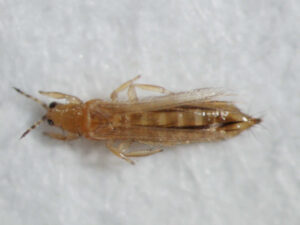Now that spring grains like wheat and rye have dried down and are being combined, thrips in those fields will move to vegetable crops, especially when small grains are adjacent to vegetable fields. Thrips are very small and often missed if casually looking at a plant since they hide in blossoms, under sepals, on under sides of leaves and other protected areas on the stems, leaves and flowers. To scout for thrips look at plant parts mentioned above. It is also important to dissect a flower, pulling back petals and sepals to find hiding thrips. It is difficult to see thrips with the naked eye. Therefore, the use of a hand lens will help.
Most adult thrips are elongate, slender, very small (less than 1/20 inch long), and have long fringes on the margins of both pairs of their long, narrow wings. Immature thrips (called larvae or nymphs) are oblong or slender and elongate and lack wings. Most thrips range in color from translucent white or yellowish to dark brown or black. See the photo of an adult thrips below by Dr. David Kerns, Professor, IPM Coordinator and Extension Specialist, Texas A&M AgriLife Extension, College Station.
Thrips hatch from an egg and develop through two actively feeding larval stages and two nonfeeding stages, the prepupa and pupa, before becoming an adult. Late-instar larvae change in appearance and behavior and are called prepupae and pupae, even though thrips do not have a true pupal stage.
Females of most plant-feeding species lay their elongate, cylindrical to kidney-shaped eggs on or into leaves, buds, or other locations where larvae feed. Thrips have several generations (up to about eight) a year. When the weather is warm, the life cycle from egg to adult may be completed in as short a time as 2 weeks.
Thrips will feed on most all vegetable crops – solanaceous crops like eggplant, tomatoes, peppers, white potatoes, cucurbit crops like cucumber, squash and melons, bean crops, allium crops like onions, garlic and leeks and others.
Thrips feeding on plants can damage fruit, leaves, and shoots and very noticeably affect plants’ appearance. Leaves may be speckled on the top surface from feeding on under sides of leaves by the insect’s sucking mouthparts. Damage to fruit, like tomatoes may not appear until fruit ripen and can be seen as gold flecks on red tomato fruit. For many thrips species, by the time their damage is seen, such as after flowers open or fruit forms, the thrips may no longer be present.
Once thrips are identified, control can be difficult when they are found in high numbers. Preventative measures like the use of row covers and reflective mulch have some success. Both conventional and organic insecticides labeled for thrips control can be found in the Rutgers Commercial Vegetable Production Recommendations guide under the sections for individual vegetable crops. Always read the pesticide label for instructions, safety precautions, application rates and restrictions. Since thrips hide in tight areas of plant parts it is important to have good coverage and penetration when applying insecticides to reduce the population of this hard to control pest.
For more detailed information about thrips see the Rutgers Fact Sheet https://njaes.rutgers.edu/pubs/publication.php?pid=FS291

